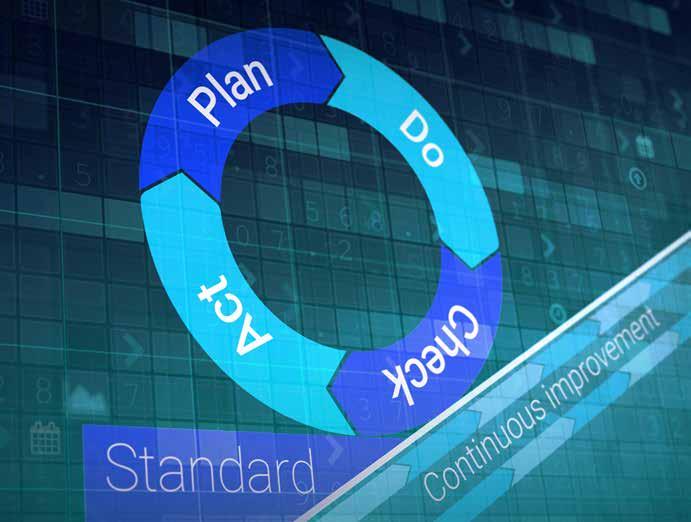
9 minute read
Innovation Through Supply Chain Optimization
from JHC October 20
Moving strategies forward in an age of disruption
BY DEE DONATELLI
Innovation is typically viewed as the application of a better solution that meets new require-
ments or market needs. Upon further review, the definition of innovation is also an incremental improvement of an existing thing or an improved way of doing things.
Supply chain management is a myriad of management practices, with multiple areas for incremental improvement/innovation. Optimization of supply chain management practices can occur in acquisition cost and standardization activities, as well as in improving utilization via process improvement, standardizing clinical practice, and waste avoidance.
Improved supply chain management skills, and supply chain optimization strategy and activities are needed today more than ever before. In a SYFT sponsored survey reported in 2020, 97% of hospital leaders agreed optimization could reduce costs. Methods to reduce costs include proactively identifying cost savings opportunities by tracking inventory more efficiently, tracking and comparing costper-case outcomes, identify and report surgical supply use variance, and discussing variance with surgeons.
In the same survey, 75% of respondents agreed the same optimization efforts would improve quality of care through time savings and efficiency improvements, cost savings, happier physicians and staff, a reduction in expired supplies, and improved recall management (SYFT, 2020).
Value-based purchasing Value-based purchasing is a driver for optimizing supply chain practices. Valuebased purchasing is the process that considers (1) safe and effective products, (2) products judged as superior and covered by payments (3) products accepted and prescribed by physicians and, (4) products preferred and utilized by consumers.
In a 2018 CAPS RESEARCH study, 88% of the respondents said “improving data transparency across the supply chain” was a defining factor associated with value-based purchasing and important for consideration over the next five years. However, price transparency, without accompanying evidence regarding quality, could lead to decisions detrimental to both providers of care and patients.
Managing spend and achieving value in supply chain decision making requires data sets to address all purchasing decisions. Creating a comprehensive analytics platform that begins with the request to buy and supports and analyzes both proactively and retrospectively all sourcing activity is fundamental in value management and allows progression to clinical equivalency and a focus on outcomes. When coupled with clinical evidence we have robust data sets to support decision making for all types of decisions, whether the focus is demand, cost, standardization, or outcomes.
Supply chain optimization has several critical success factors. The ability to understand current state (spend) is imperative in standardization efforts, but is merely the first step in successfully achieving sustainable savings and “success,” as defined by maintained or improved patient outcomes.
Supply chain optimization means
Supply chain optimization means understanding your current state, focusing upon specific areas of improvement, and then getting the job done. Statistics show that most innovations fail as a result of the lack of implementation and follow through.
understanding your current state, focusing upon specific areas of improvement, and then getting the job done. Statistics show that most innovations fail as a result of the lack of implementation and follow through. Innovation is not just about coming up with some fancy new way to do things but rather a consistent and incremental improvement strategy on the things we do every day.
What I have recognized over the past several months is that is we do not lack the ability, but we do often lack agility in getting things done. I have seen organizations move strategies forward in a matter of weeks that would have taken years preCovid. What have you been focused upon in regard to optimizing your supply chain innovative abilities?
Dee Donatelli, R.N., CMRP, CVAHP, has more than 40 years of experience in the healthcare industry as a registered nurse, supply chain executive and consultant. Donatelli has held leadership positions in hospitals, consulting firms, distributors and GPOs. Donatelli is a past president of the Association of Healthcare Value Analysis Professionals (AHVAP) and is the current Chair of the Association for Healthcare Resource and Materials Management (AHRMM). An Bellwether Class of 2015 inductee, she also serves on Bellwether League’s Board of Directors. Donatelli currently serves as VP of Professional Services at TractManager and as Principal, Dee Donatelli Consulting, LLC. She can be reached at Dee@DeeDonatelli.com.
Eliminating Inefficiencies in Implant Purchases
The old way of processing implant purchases and preference items is draining supply chain teams of their most precious commodity – time.

Implant purchases and preference items cause a lot of headaches for
hospital and health system supply chain teams. They also generate a tremendous amount of paperwork.
In an age of digital, streamlined solutions, the process for implant purchases and physician preference items has maintained a reliance on paper forms and manual processes to get things done.
It starts with a vendor rep typically filling out a paper form for a requisition of a product that is a bill-only product (such as an orthopedic implant). Someone at the hospital must receive the form, then manually research to see if that exact product was used in a case, and then manually verify if the right price with the right discount was applied to it. That same person has to then go into the materials management information systems (MMIS) system and request a purchase order (PO) for that product, which is then sent to the vendor.
“For a lot of hospitals, the purchasing of bill only products can be a time consuming and laborious process,” said Angela McNally, Vice President, Provider Solutions for Owens & Minor. “These products typically are not captured by a standard MMIS, and because of that, most providers rely on paper forms and manual interventions to get them approved and purchased,” McNally continued.
Fortunately, there are new solutions being introduced to the market designed to simplify a tedious process by eliminating manual work and manual processes.
Streamline the Bill-Only Process One of those solutions is Owens & Minor’s Bill Only Management solution. “We developed Bill Only Management with the express purpose of making the purchase cycle for bill only products easier for both the hospital and the vendor,” McNally said. “We wanted the solution to simplify the process so that that the purchase cycle could be counted in days or even hours instead of weeks and months.”
Owens & Minor’s Bill Only Management is a fully automated, cloud-based solution for bill-only products that streamlines the process, eliminates inefficiencies, saves time, and puts up some “guardrails” to ensure the right pricing is applied to the products. It does this by:
“Digitizing” the information. Instead of forms that are manually filled out, the
information is collected/captured online via Bill Only Management.
Reducing the potential for errors.
There are fewer errors on the person receiving the information because of bad handwriting, etc.
Allowing transparency/visibility
into the process. If you want to know where a PO or other document is at any one time, Bill Only Management provides that visibility. Bill Only Management provides insights via reports for better decision making that you wouldn’t get via a manual process.
Shortening time-consuming tasks. Because the contracts are loaded into Bill Only Management, it cuts down on the
Pain Points
How painful and time-consuming can implant purchases and preference items be for a hospital or health system? Consider: ʯ Many of these preference items are walked in by the vendor the day of the procedure, so they are not captured in the standard MMIS and must be manually manage. ʯ The vendor rep manually submits a requisition for the implant and submits it to the hospital.
ʯ
ʯ
ʯ
ʯ
Manual validation of contract pricing must occur. The manual approval process for implants requires routing the form to the right person for approval (wet signature). A PO must be created from that requisition. Often this too is a manual form and must be typed in to the MMIS system for PO creation. There is a lack of visibility in the process (i.e. whose “desk”
ʯ
ʯ
is the PO/requisition on), and a duplication of efforts (i.e. the clinical staff and buyer working to get same information and proper approvals). It’s inefficient (too much time spent on these manual tasks and approval process highly dependent on availability of approvers) Finance departments may undertake manual processes to apply complex discounts, pricing tiers and capitation agreements.
time verifying prices and helps ensure the provider is paying the correct negotiated price every time. Also, automatic workflows are used to route the right document to the right person for approval instead of sticking it inter office mail or sending as an attachment. This speeds up the process.
Simplified training. Owens & Minor will manage the training and implementation of the software, which in return saves the supply chain team time and money.
Bill Only Management enables hospital to simplify the entire purchase cycle for bill only products, from the time when a vendor tills out a requisition to the time a PO is issued. “What the solution ultimately does is make life easier for people involved in purchasing implants and gives them back time to do other, more strategic tasks instead of doing things like manually verifying a price” stated McNally.
Indeed, from its quick implementation to full utilization, Bill Only Management takes the pain out of many critical supply chain functions for hospitals and health systems. The days of looking up prices to ensure the vendor put in the right price are gone. With Bill Only Management, supply chain teams have a cloud-based solution that automates the entire purchase cycle for bill only and physician preference products, transforming a tedious and timeconsuming process into a streamlined and simplified one.

Benefits of the Bill Only Management Solution
CONTRACT PRICE MANAGEMENT:
Ensures you pay the correct negotiated price every time
CAPITATION MANAGEMENT:
Leverages an automated system for identifying capitation opportunities and modifying requisitions to reflect correct pricing LABOR OPTIMIZATION: Provides the option to shift initial case documentation to the vendor representative without any loss of input or pricing control
STREAMLINED APPROVAL PROCESS:
Centralizes bill-only purchase approvals to 1-2 people across a single hospital or network by automating requisitions, purchase orders, and invoice receipts ENHANCED REPORTING: Enables you to create and share custom export reports by procedure, physician, contract, product, price, or any number of metrics
QUICK ACCESS TO KEY DATA: Provides easily accessible data regarding procedure, vendor, and utilization that can be used to manage overall business or prepare for audits and recalls










